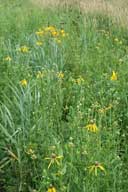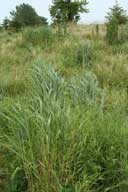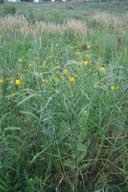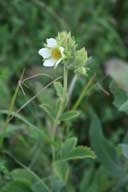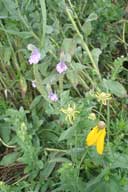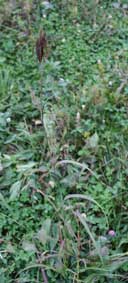We some regrets, year 4 began with the knowledge that my wife and I would be relocating our little farm. Our new place has much more land that is sorely in need of rehabilitation. This summer I had no time to mow the prairie. Being the fourth year I think it should have been burned but instead it was left to its own. As mid-July approach we were dazzled by what it had in store for us.


Sunday, 11 June 2006
After an exceedingly dry winter, we've had short rain events totaling less than 4" inches through our rainy season!
Conditions are very dry but the prairie area burst forth with life anyway. It looks real messy to me but this fits with warnings we received from the experts. I sharpened up a Bush Hog mower and beat back the first wave of weeds.





We're not sure what's growing out there yet. There's deep green clumps of grasses that look like they could be turf grass but we don't know how such grasses would be out there. So we'll call them prairie grass until it proves otherwise. There's a large amount of thistle, and what we call "Pig Weed". After roaming through the jungle we've discovered we don't know what new prairie seedling look like. We're off to the library to see what we can learn about them.
Thursday, 10 November 2005
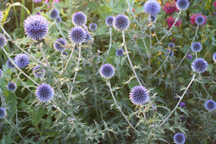
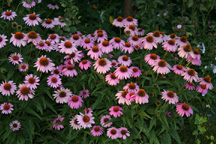
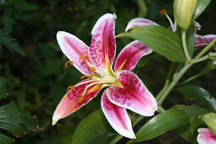
My wife is an avid flower gardener who has long dreamed about managing her own swath of prairie.
In late spring of 2004, we dedicated two unused acres of land to bringing her dream to life.
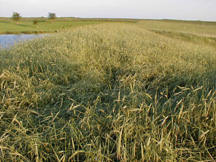
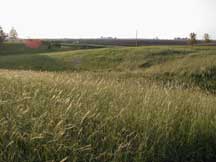
The site has rolling slopes with two shallow runoffs that form a "V-shaped" contour. The open end of the "V" faces east and its point converges beyond our fence line to the west. Long ago, the previous owner constructed an earth dam
across the southern slopes of the "V" to form a pond uphill to the east. Just prior to our ownership, the dam underwent repairs
to a leak. When we took ownership the area was sprouting a fast growing annual fescue grass typically found along highway construction sites to control erosion. It's attractive but dies off over winter. Other areas of the site were dedicated to the
agricultural Crop Reserve Program and seeded with a variety of cover grasses (and a thriving weed population).
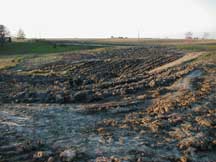
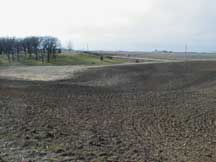
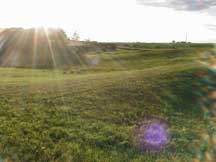
Two years later we had some dredging done around the pond edges to remove field silt from runoff. Construction crews spread the wet sloppy silt below the dam to dry through the winter. In the spring it was landscaped and seeded with rye grass, clover and other varieties. Each subsequent spring we burned off the dead growth from the winter
then let the area reestablish growth through the summer. For the most part the site became an eye sore. This was a perfect location for us to try our hand at prairie management.
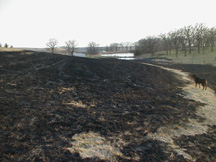
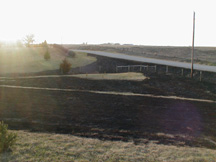
We discussed the plan with our neighbors to the west. They were very receptive, encouraging, and enthusiastic
about the plan. We then contacted a local farming cooperative and spoke with an agronomist.
The agronomist said the coop (pronounced "coh-op") could handle site preparation and seeding. He offered to drive by the site and let us know what the effort
would cost. Following up a few days later we learned the coop's equipment is much too large for
our small area. Their herbicide sprayer alone is a 90 feet wide!
Next we sought someone with smaller equipment but came up empty handed. We knew that multiple sprayings would be needed to kill off spring-summer-fall weed emergence. It was becoming clear that I would be "the path of least resistance" for the job. Having little experience in this function, I queried co-workers for advice. I was directed to a local manufacturer of agricultural sprayers. They had all sizes and shapes. I settled on a pull behind sprayer with a 60 gallon tank, 58 inch boom, hand sprayer, and electric pump. The unit would tow behind my lawn tractor while tapping its electricity supply to drive the pump. Now what to
put in the sprayer's tank?
Having been in crop reserve for many years, the selected site developed diverse weed populations. The coop's agronomist
recommended generic glycophosphate combined with amonium nitrate. He noted the generic brands are less expensive but would take longer to work. The amonium nitrate would add an extra "burn" to further stress the weeds and assist in the kill rate. After two applications separated by several weeks we discovered some weed resistance to the herbicide combination. We selected a few specimens to show the agronomist who suggested adding an RD4 generic to the next spraying. The new combination of herbicides knocked out most everything growing in the area. Other than avoiding spraying myself, the weed control process was quite dull; however, dramatic changes resulted. The weeds receded revealing bare ground.
We hoped to apply prairie seed in the fall of 2004, but after some consideration, decided to wait until spring of 2005.
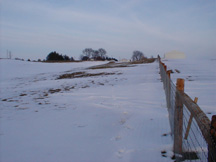
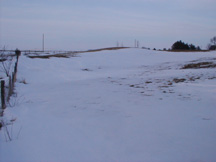
These winter photos are from earlier years as we barely had any snow cover throughout 2004-2005.
As spring approached my wife began contacting prairie seed suppliers. Iowa is fortunate to
have several prairie experts. We gravitated towards a gentleman name Carl Kurtz who has a long history in prairie management and seed production. Carl authored the book "A Practical Guide to Prairie Reconstruction" which we reference frequently. My wife exchanged several e-mails with Carl explaining her prairie interests in forbs and grasses. He recommended a fall planting
as the seed should over winter for best germination in the spring. I groaned
quietly as I'd have to continue weed controll for another season. Expecting that I cleared the ground the previous year, I shrugged off the task. I
would soon learn how very wrong I was about biodiversity. Much to my surprise the
two acres blossomed in vigorous weed growth that following summer. Before it
ended I sprayed the entire area three more times and spot sprayed into mid-October!
As fall approached we turned our attention to the seeding operation. Carl recommended a not too distant neighbor (also known as Bob) who lived about 12 miles east of us. We exchanged a few e-mails with Bob describing the project.
Bob responded with a treasure trove of prairie management information. He visited with us to walk the site. With a surveyor's rigor, he measured our odd-shaped acres splitting them into several triangles to estimate the total area. He arrived equipped with agricultural satellite maps showing our pond and surrounding property. He explained how he would calibrate his broadcast seeder to ensure the recommended seed density of 15 pounds per acre. Bob took his triangulation notes and maps home to complete the estimate.
He also informed us that he would be traveling to Carl's the following weekend
to assist with seed harvest and bagging operations. A couple days later Bob e-mailed us his estimate of 2.2 acres. We were in very good hands!
During this time, our future prairie seed was approaching harvest about an hour away at Carl's place.
We learned from Bob, that harvest occurred the last weekend of October and that
he took couple sacks home to his shop for calibration work. He let us know that
Carl was expecting seed certification that same week; after which we could pick
up our order. A week or so later on the cold, overcast, and dreary day of
November 5th, we traveled to Carl's. He showed us to his barn we the seed was
stored. The seed came in white puffy pillow-shaped sacks. Each contained 5 pounds of actual prairie seed and 20 pounds of
ground prairie matter. Carl harvests the seed with a modified combine that chops the prairie plants and their seeds into a course mix. Through a rigorous sampling process the mix is certified to contain a minimum of 5 pounds of seed per 25 pound sack. The seed mix itself is expected to contain a minimum 40 varieties of forbs and grasses.
Carl's home is surrounded by woodlands and established prairie. He invited us to walk
the prairie paths while he prepared our receipt. Due to the cold we only walked a short distance down the hillside.
To our surprise, the prairie was buzzing with life so late in the fall. In addition to pheasants, deer trails, rabbits and many species of native non-migratory birds the plant life was stunning.
Though most plants were going dormant, it was clear the varieties were atypical of anything I'd seen in Iowa. Feeling the cold we cut the walk short. Carl invited
us to return in the summer months (I'm sure we will!).
The big seeding day arrived on November 10th. In the brisk morning air, Bob drove his tractor
and seeder the many miles to our place. After warming up for a bit, he went right to work seeding our future prairie!

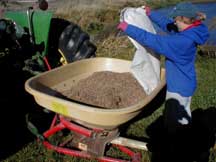
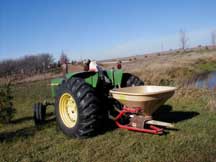
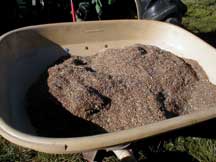
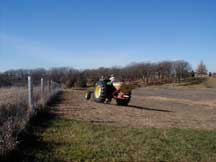
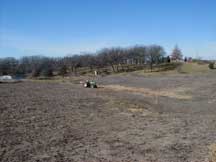
The next two weeks brought a series of seasonal weather changes. Rain on November 13th, broke into very high winds over the following days. By high winds I mean strong steady high winds that make it impossible to be outdoors for very long. You lose hats, yard furniture, bird feeders, and most anything not tightly secured.
Another tumultuous weekend followed on November 19-20th with thunderstorms, more high winds (sustained 40+ mph with gusts to 60), heavy rain, then snow and by deep cold spell (lows near 9 degrees F). The ground had
built up a frost layer. Finally, the first week of December brought a series of snow falls totally some 14 inches. Through this time I'm wondered about the weather's impact on our prairie seed distribution. I wondered how the prairie seed, simply broadcast on the ground, would not blow away or runoff into ditches? Bob forwarded my wife an e-mail he received from Carl in which he noted that it was good that we seeded when we did. The planting season was off to a good start! I guess
we have trust nature from here out.
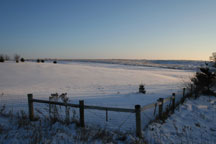
Over the next months and years we'll keep telling this story and illustrating the evolution of our prairie project. I'm told I will need to mow it to 6-12 inches in height for the first couple of years. I'm not sure how I will accomplish that with my current equipment but I have the winter to figure it out. Visit here from time to time to see how we do bringing the prairie to Prairiehill Farm.
If you'd like to contact us we can be reached by e-mail at gdclinch AT wildblue DOT net.









